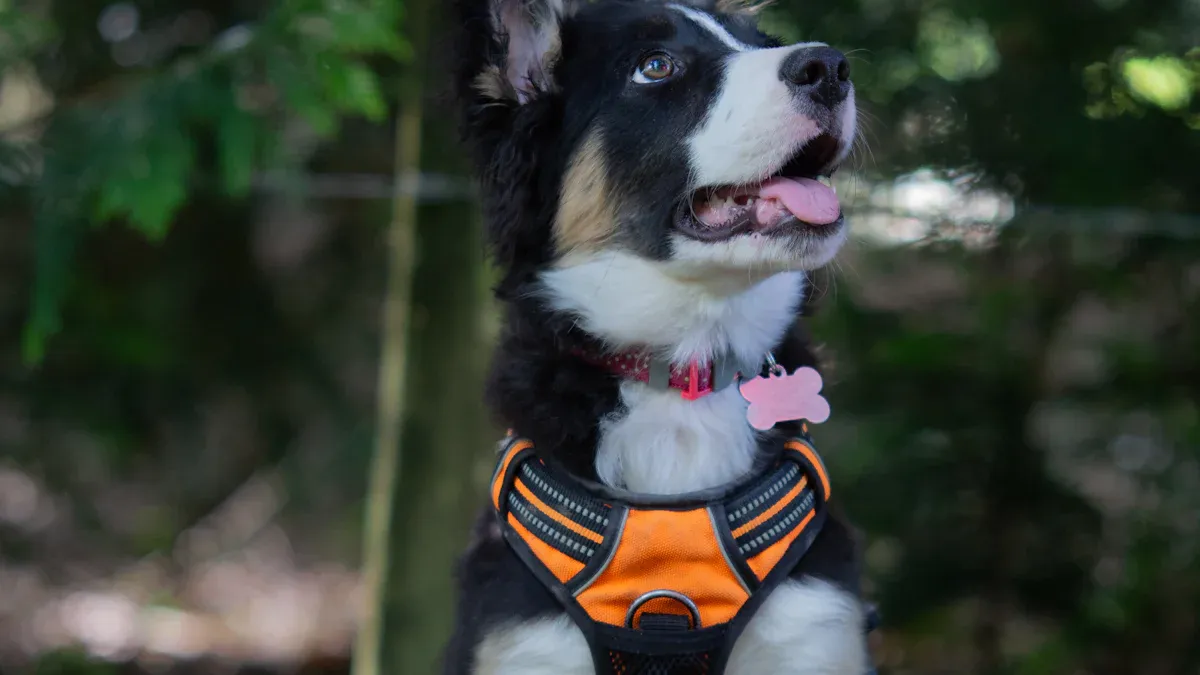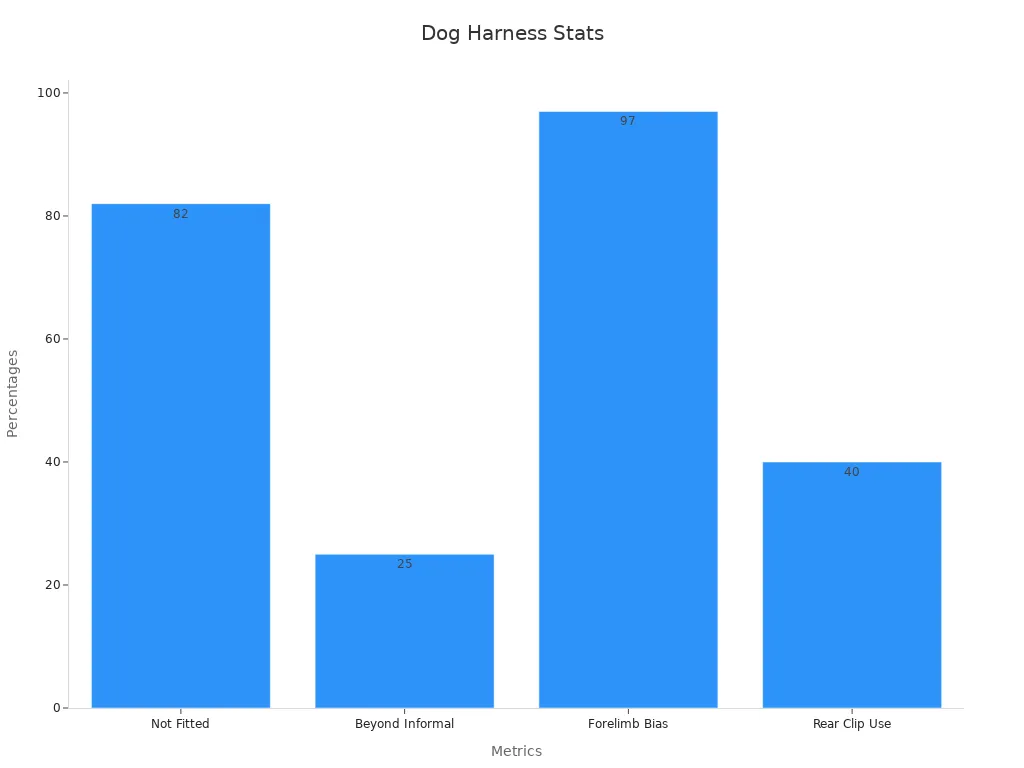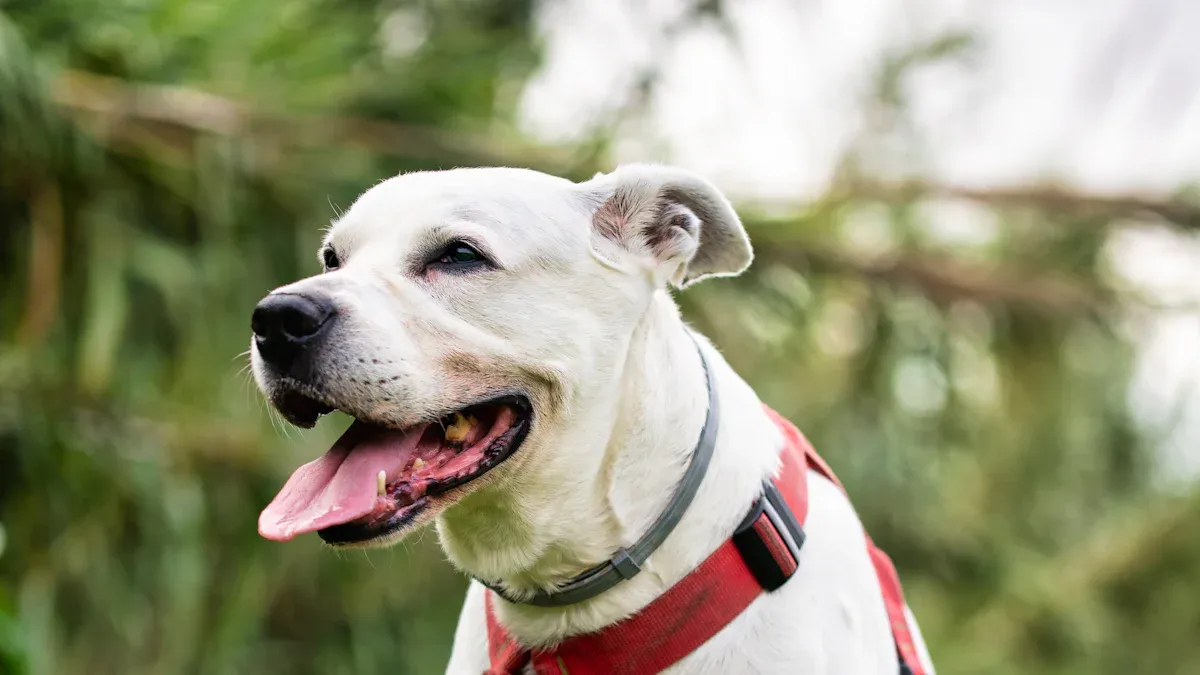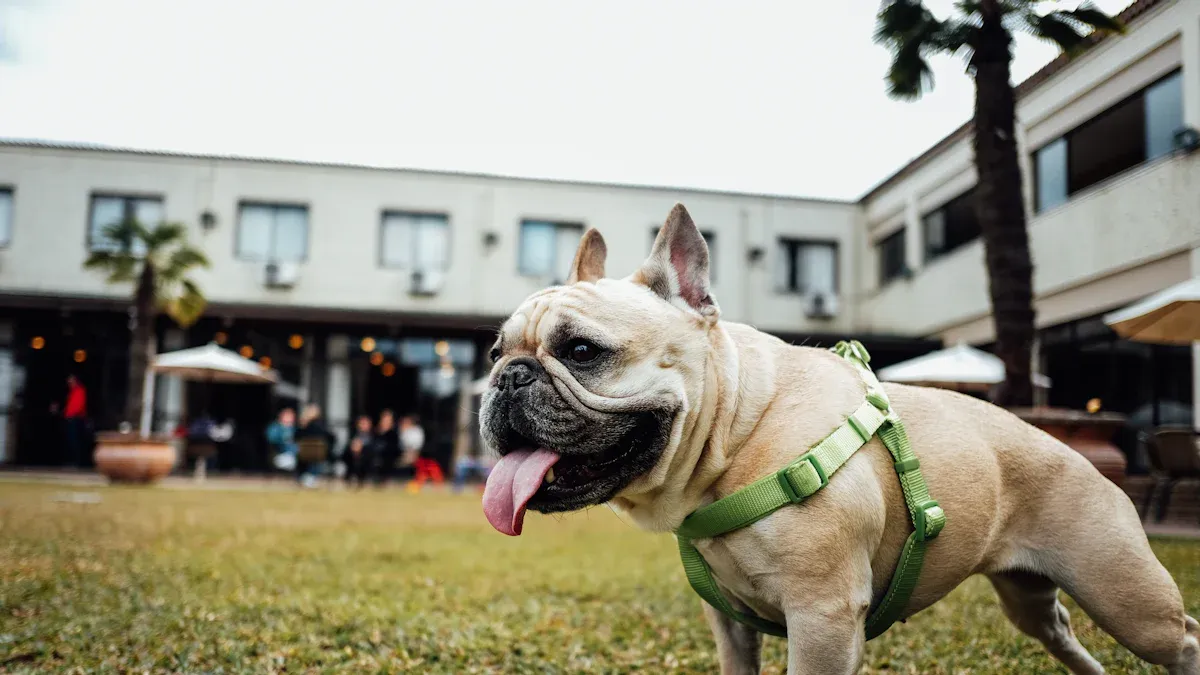How to Choose the Right Dog Harness: A Complete Guide

Choosing the right dog harness starts with knowing what matters most for your pup—fit, comfort, and safety. You want a harness that matches your dog’s size, energy, and daily life. A well-fitted harness keeps your dog happy and healthy. Recent studies found that 82% of dog owners never got a professional fitting, and 97% of dogs showed changes in how they walk just from the wrong harness design.

When you know how to choose a dog harness, you help your dog move better and stay safer every day.
Key Takeaways
-
Pick a harness that matches your dog's size and actions. Make sure it is comfy and safe for your dog. Measure your dog's chest and neck with care. Use the straps to adjust the harness so it fits well but is not too tight. Choose a front-clip harness if your dog pulls a lot. Use a back-clip harness for calm dogs. Try a dual-clip harness if you want more control. Find harnesses with soft padding to keep your dog comfy. Strong buckles help the harness stay on. Reflective parts help others see your dog. Clean the harness often to keep it nice. Get a new harness if you see any damage. This keeps your dog safe on every walk.
How to Choose a Dog Harness
Key Factors
When you start thinking about how to choose a dog harness, you want to focus on what matters most for your dog’s daily life. Every dog is different. Some love to run and play, while others prefer slow walks. Puppies in training need something different from older dogs. You also want to think about your dog’s size, age, and behavior. For example, a pulling harness works well for dogs that like to pull, while a hiking and everyday harness fits active dogs who join you on trails.
Here’s a quick look at how dog size and behavior can affect your choice:
|
Behavior During Harnessing |
Small Dogs |
Medium Dogs |
Large Dogs |
|---|---|---|---|
|
Jumping on Handler |
23.3% |
53.6% |
34.7% |
|
Grabbing Equipment |
12.1% |
28.4% |
19.5% |
|
Mouthing Handler |
8.7% |
21.2% |
15.3% |
|
Vocalizing |
5.2% |
13.9% |
10.8% |
|
Pulling on Leash |
31.4% |
47.8% |
39.2% |
You can see that medium dogs often show more jumping and pulling. Puppies and young dogs also tend to jump and mouth more. That means you’ll want to match the harness style to your dog’s habits. If your dog pulls, a pulling harness with a front clip helps you guide them. For calm, well-trained dogs, a back-clip harness may be the best harness for easy walks.
Tip: Think about your dog’s daily routine. Do you walk in the city, hike in the woods, or train at the park? The right dog harness will make every outing safer and more fun.
When you look for a dog harness recommendation, check for these main factors:
-
Comfort and padding
-
Material quality and durability
-
Adjustability for the best fit
-
Features for your dog’s activity (like reflective trim or handles)
Fit and Sizing
Getting the proper fit is the most important step in how to choose a dog harness. A harness that fits well keeps your dog comfortable and safe. It also helps you control pulling and prevents injuries. You want the harness to be snug but not tight. Here’s how you can measure for the best fit:
-
Measure the chest girth: Use a soft tape measure around the widest part of your dog’s chest, just behind the front legs.
-
Measure the neck: Some harnesses need a neck measurement. Wrap the tape around the base of the neck, where a collar would sit.
-
Check the size chart: Every brand has its own sizing. Always check the chart before you buy.
-
Try the one/two finger rule: Once the harness is on, you should be able to slide one or two fingers between the harness and your dog’s body. This means it’s snug but not too tight.
Note: Adjustable straps help you get the best fit, especially for puppies who are still growing or dogs with thick coats.
Studies show that adjustable harnesses with padded straps reduce the risk of chafing and injury. They also make it easier to get a secure fit as your dog’s size changes. The Harness Evaluation Tool (HET) used by guide dog handlers shows that handler feedback and regular fit checks help keep dogs comfortable and safe, especially for breeds like Labradors.
Here’s a quick checklist for sizing:
-
Measure chest and neck before shopping
-
Choose adjustable harnesses for growing puppies or seasonal coat changes
-
Check fit every few weeks, especially after grooming or weight changes
Comfort and Safety
You want your dog to feel good and stay safe every time you use a harness. Comfort comes from soft padding, breathable materials, and a design that lets your dog move naturally. Safety comes from strong buckles, reinforced stitching, and secure leash attachment points.
-
Harnesses spread pressure across the chest, not the neck. This helps prevent injuries, especially for dogs that pull or have breathing problems.
-
Padded harnesses protect against chafing and irritation. Look for harnesses with soft mesh or foam lining.
-
Reflective trim and bright colors help drivers and cyclists see your dog at night.
-
Metal buckles and double stitching add strength and durability.
Veterinary experts say that high-quality harnesses prevent neck injuries by spreading pressure evenly. They also help dogs with health issues like tracheal collapse or spinal problems. For car rides, crash-tested harnesses keep your dog safe in case of an accident.
Tip: If your dog pulls a lot, try a dual-clip or Y-shaped harness. These styles give you more control and protect your dog’s joints and spine.
Some harnesses come with special features for extra safety and comfort:
-
Ergonomic handles for quick control
-
Multiple leash attachment points for training or walking
-
Easy-to-clean materials for daily use
When you choose the best dog harness, you help your dog enjoy every walk. You also make training easier, especially for puppies in training. If you want a dog harness recommendation, look for one that matches your dog’s size, behavior, and favorite activities. The best fit and right features will keep your dog happy, healthy, and ready for adventure.
Dog Harness Types

Picking a dog harness can seem hard at first. But you can make it easier by thinking about your dog’s habits. Each harness style works best for certain dogs and situations. Let’s look at the most common types so you can pick the right one.
Back-Clip
A back-clip harness is a popular choice at parks. The leash clips to a ring on your dog’s back. This spot is between the shoulders. Calm dogs who do not pull much do well with this harness.
Here is how back-clip harnesses work:
|
Aspect |
Back-Clip Harness Performance |
|---|---|
|
Ease of Use |
Simple to put on; dogs get used to it fast |
|
Comfort |
Feels good; protects the neck area |
|
Leash Tangling |
Leash rarely gets caught under the legs |
|
Suitability for Small Breeds |
Great for small dogs with delicate throats |
|
Control for Large/Aggressive Dogs |
Not enough control for strong or aggressive dogs |
|
Directional Steering |
Does not help you steer your dog |
|
Popularity |
Very popular; many styles to choose from |
If your dog is small or has a weak neck, this harness is gentle. But if your dog pulls a lot, you may need a different style.
Front-Clip
Front-clip harnesses have the leash ring on the chest. This helps you guide your dog and turn them if they pull. Trainers like this style for teaching dogs not to pull.
-
Good for training and stopping pulling
-
Gives more control than back-clip harnesses
-
Helps teach better leash skills
If your dog pulls or gets distracted, a front-clip harness can help.
Dual-Clip
Dual-clip harnesses have rings on the back and chest. You can switch between both for walks or training. Experts say dual-clip harnesses are great for strong pullers. The front ring helps with training. The back ring is good for easy walks. Many dual-clip harnesses have soft padding and adjust easily. They are comfy and hard for dogs to escape.
If you want a harness for all situations, dual-clip is a smart choice.
Step-In
Step-in harnesses are quick and simple. Your dog steps in, and you clip it on their back. This is good for dogs who do not like things over their heads. It is also good for owners who want something fast.
-
Easy to put on, even for wiggly dogs
-
Works well for small and medium dogs
-
Not the best for strong pullers
If your dog is calm or older, a step-in harness is a gentle choice.
Y-Shaped
Y-shaped harnesses give great support and comfort. Here is why many people like them:
-
Spread pressure across the chest and shoulders
-
Help dogs with breathing problems or weak necks
-
Improve posture and lower joint problems
-
Let dogs move freely without blocking shoulders
-
Have many ways to adjust and soft padding
-
Often have reflective parts and handles for safety
Y-shaped harnesses are good for active dogs or those who escape. Many escape-proof harnesses use this shape to keep dogs safe.
Picking the right harness helps your dog enjoy walks and stay safe. Try different types to see what fits your dog best.
At Gabby Whale, we believe every dog deserves a harness that fits like a hug. Our designs combine thoughtful engineering, sustainable materials, and aesthetic care to give your pet the comfort and security they deserve.
Gabby Whale Dog Harnesses
If you want a harness that’s safe, stylish, and eco-friendly, Gabby Whale has you covered. Many pet owners now look for brands that care about the planet and their pets’ health. Gabby Whale uses recycled plastic bottles and safe, chemical-free materials. You get a harness that’s both tough and good for the environment. Here’s a closer look at their top options:
No Pull Dog Harness
You’ll love the No Pull Dog Harness if your dog gets excited or pulls on walks. This harness uses strong nylon webbing and soft mesh padding. It has two leash clips—one on the chest for training and one on the back for relaxed walks. The four-point adjustment system helps you get a snug fit. The ergonomic handle on top gives you quick control in busy places. Reflective stitching keeps your dog visible at night. This harness works best for medium to large dogs who need extra guidance.
Specs:
-
Materials: High-density nylon, breathable mesh
-
Sizes: XS to XL
-
Features: Dual-clip, reflective trim, top handle, quick-release buckles
LED Smart Dog Harness
If you walk your dog early or late, the LED Smart Dog Harness lights up your path. It has built-in LED strips that shine in different colors and modes. The lights make your dog visible from far away, even up to half a mile. The harness is water-resistant and has a rechargeable battery. You can attach a GPS tracker for extra peace of mind. The padded handle and adjustable straps keep your dog comfy and secure. Many pet parents like this harness for its safety and tech features.
Specs:
-
Materials: Nylon, mesh, LED components
-
Sizes: S to XL
-
Features: Rechargeable LED lights, tracker pocket, reflective trim, padded handle
Step-In Dog Harness
The Step-In Dog Harness makes getting ready for walks easy. Just lay it flat, have your dog step in, and clip it on the back. This design spreads pressure across the chest, not the neck. It’s great for small to medium dogs, seniors, or dogs with sensitive necks. Many owners say it’s comfortable for long wear and perfect for dogs who hate harnesses that go over the head. Make sure to adjust the straps for a secure fit.
Specs:
-
Materials: Nylon webbing, SBR padding
-
Sizes: S to L
-
Features: Step-in design, three-point adjustment, reflective strips, quick-snap buckles
Ultra-Lightweight Reflective Dog Harness
If your dog loves to run or hike, try the Ultra-Lightweight Reflective Dog Harness. It uses CORDURA® fabric, which is strong but super light. The mesh lining keeps your dog cool and dry. Aluminum buckles add strength without extra weight. Reflective trim helps cars see your dog at night. The top handle gives you control on trails or in crowds. This harness is perfect for active dogs or hot weather.
Specs:
-
Materials: CORDURA® fabric, mesh, aluminum hardware
-
Sizes: XXS to XL
-
Features: Ultra-light, full adjustability, ergonomic handle, 360° reflective trim
Stylish Dog Harness and Leash Set
Want your dog to look sharp? The Stylish Dog Harness and Leash Set uses real Harris Tweed in a classic plaid. It’s soft inside and adjusts for a perfect fit. The set comes with a matching leash and a handy poop bag hook. Reflective accents help with evening walks. This harness is great for city strolls, travel, or special events.
Specs:
-
Materials: Harris Tweed, padded interior
-
Sizes: S to L
-
Features: Matching leash, waste bag clip, adjustable fit, reflective details
Gabby Whale stands out for eco-friendly materials, safe designs, and smart features. You can feel good about choosing a dog harness that’s both stylish and responsible.
Fitting the Right Dog Harness

Measuring Your Dog
Getting the right fit for your dog harness starts with good measurements. You want your dog to feel comfortable and safe, whether you have a tiny puppy or a big, strong adult. Here’s a simple step-by-step guide you can follow at home:
-
Grab a soft tape measure.
-
Measure around the widest part of your dog’s chest, just behind the front legs. This is called the chest girth.
-
Measure around the base of the neck, where a collar would sit.
-
Write down both numbers and check the size chart for your chosen harness.
-
If your dog is between sizes, pick the larger one for a better fit.
Dogs come in all shapes and sizes. Studies show that even small changes in harness placement can affect how your dog moves. That’s why you want to measure carefully, especially for puppies in training or growing puppies who change size quickly.
Tip: For wiggly puppies, ask a friend to help hold them still. Treats work wonders!
Adjusting for Comfort
Once you have the harness on, it’s time to adjust the straps. You want the harness to be snug but not tight. Try the “two-finger rule”—you should fit two fingers between the harness and your dog’s body. This helps prevent rubbing and keeps your dog comfy.
-
Check that the straps don’t twist or dig into the skin.
-
Make sure the chest plate sits flat and doesn’t ride up.
-
Look for padded areas that protect against chafing.
A table from recent studies shows that different harness types work better for different dogs. Some harnesses give more support, while others let your dog move more freely. Always adjust the harness to match your dog’s shape and activity level.
|
Harness Type |
Best For |
Comfort Level |
|---|---|---|
|
Active dogs, puppies |
High |
|
|
Straight Breastplate |
Stability, support |
Very High |
|
Small dogs, seniors |
Good |
If your puppy seems uncomfortable, try loosening the straps or switching to a padded harness.
Common Fit Mistakes
It’s easy to make mistakes when fitting a dog harness, especially with puppies or squirmy dogs. Here are some things to watch out for:
-
Straps too loose: Your dog might slip out.
-
Straps too tight: This can cause chafing or limit movement.
-
Harness sits too high or low: It should rest on the chest, not the neck or belly.
-
Forgetting to check fit after grooming or growth: Puppies grow fast, and even adult dogs can change shape.
Dogs move differently in each harness. Studies found that the wrong fit can change how your dog walks and even affect their joints. Always check the fit every few weeks, especially for puppies and growing puppies.
Remember, a well-fitted harness keeps your dog safe and happy on every walk.
Using and Maintaining Your Dog Harness
Frequently Asked Questions (FAQ)
-
Can I use these harnesses for puppies?
Yes! Many of Gabby Whale’s harnesses are available in sizes as small as XXS, making them suitable for puppies and small breeds. -
How do I clean my dog harness?
Most of our harnesses can be hand-washed with mild detergent and air-dried. Check each product’s care instructions. -
How do I know if the harness fits correctly?
A well-fitted harness should allow you to slide two fingers under any strap and should not rub or pinch your dog.
Putting On and Taking Off
Getting your dog harness on and off should feel easy for both you and your pup. Lay the harness flat and let your dog sniff it first. This helps them relax. For step-in harnesses, guide your dog’s front legs into the openings, then pull the harness up and clip it on their back. For over-the-head styles, slip the harness over your dog’s head, then fasten the chest and belly straps. Always check that the straps sit flat and don’t twist.
Tip: Give your dog a treat after putting on the harness. This makes harness time a positive experience!
When you take the harness off, unclip the buckles and gently slide it away. Avoid pulling or tugging, especially if your dog has long fur.
Cleaning and Care
A clean dog harness keeps your dog comfortable and healthy. Dirt and sweat can build up fast, so regular cleaning is important. Here’s how you can keep your harness in top shape:
-
Wash the harness with mild detergent and cold water. This protects the fabric and keeps colors bright.
-
Air dry the harness in a well-ventilated spot, away from direct sunlight. Sunlight can fade colors and weaken materials.
-
Check the harness for dirt, hair, or stuck debris after every walk.
-
Store the harness in a cool, dry place. Avoid leaving it in a hot car or damp area.
Always follow the care instructions from the manufacturer. Some harnesses have special cleaning needs, so check the label before washing.
When to Replace
Even the best dog harness won’t last forever. You should check your harness before every walk. Look for signs like frayed stitching, cracked buckles, or stretched-out straps. If you spot any damage, it’s time for a new harness.
|
Sign to Replace |
What to Look For |
|---|---|
|
Fraying |
Loose threads, worn edges |
|
Buckle Damage |
Cracks, won’t snap shut |
|
Strap Wear |
Stretched or torn areas |
|
Fading/Weakness |
Colors faded, fabric thin |
Regular checks and quick fixes keep your dog safe. Replace worn parts right away to avoid accidents.
Taking care of your dog harness means more comfort and safety for every adventure you share!
Picking the right dog harness means you need to think about fit, comfort, safety, and what your dog likes. Experts say that harnesses with adjustable straps and soft fabric help dogs feel good and stay safe. Before you buy a harness, follow this simple checklist:
|
Step |
What to Check |
|---|---|
|
Measure |
Chest and neck size |
|
Adjust |
Straps for a snug, comfy fit |
|
Material |
Soft, non-irritating, no Velcro |
|
Features |
Reflective trim, handles, easy clips |
The right harness helps keep walks safe and fun for you and your dog!
FAQ
How do I know if my dog harness fits right?
You should fit two fingers between the harness and your dog’s body. The harness should not rub or pinch. Check that it sits flat on the chest and does not slide around.
Can my dog wear a harness all day?
You can let your dog wear a harness for walks or short outings. Take it off at home to prevent chafing or skin irritation. Always check for signs of discomfort.
How do I clean a dog harness?
Most dog harnesses clean up with mild soap and cold water. Air dry the harness away from sunlight. Always check the care label for special instructions.
Is a harness safer than a collar?
Yes! A dog harness spreads pressure across the chest, not the neck. This helps prevent choking and injuries, especially if your dog pulls or has breathing issues.
When should I replace my dog harness?
Replace your dog harness if you see frayed straps, broken buckles, or stretched-out areas. A damaged harness can break or slip off during walks.
See Also
How To Select The Ideal Carrier Bag For Pets
A Step-By-Step Guide To Finding The Best Pet Bed
Discover The Best Retractable Leash For Your Dog













